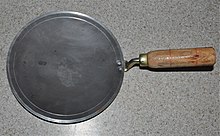Tava
A tava is a kitchen utensil used in South, Central, and West Asia to bake various types of flatbread . It is a very old kitchen ware that originated in a flat stone disk. Other spellings are Tavah , Tawa , Tawah , Tapa Saj or Sac .
Design and use
A tava is a round, flat bowl with a slight inner curve. The size varies between approx. 20 cm to over a meter. Handles or a handle may or may not be present.
As the material is mainly steel , including non-stick coating , enamels , anti-corrosion protection, and aluminum are used. There are also tavas made of fired clay, which (for smaller sizes) can be provided with a holder frame.
In the regions mentioned, the tava is heated on hotplates such as wood-burning stoves (also on the tandoor or a rocket stove), charcoal, hard coal and gas stoves ( propane / butane ).
A tawa is indispensable in households where flatbreads are regularly served with all meals. If for economic reasons it is not necessary to buy several, sometimes specialized, dishes, the tare is also used for roasting meat and vegetables.
